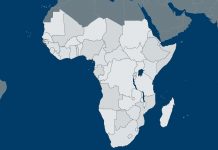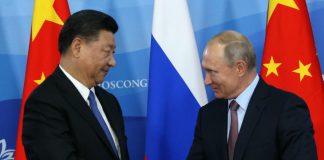A collection of Iraqi soldiers, policemen, and Sunni tribesmen are pushing into Ramadi’s city center. There are a few things to note about the headlines about Ramadi. First, the city itself has not been taken yet. Second, Ramadi is not currently of strategic importance to the Islamic State. And lastly, while many are touting the “eventual” victory of Iraqi security forces as a morale booster, this may backfire on them. After an embarrassing retreat and withdrawal, it has taken Iraqi forces outnumbering IS fighters 10-1 almost six months to begin clearing the city of IS, in no small part due to the fact that the local population has been supporting IS. The morale boost in the offing may be one for IS fighters, and not for Iraqi Security Forces.
The real silver lining for anti-IS forces in Iraq is the participation of Sunni tribesmen. That Sunni tribesmen are cooperating not just with Iraqi Security Forces but elements of the Shiite militias known as the Popular Mobilization Forces, could be the first indicator of a major challenge to IS’ ability to operate in the area. If the participation of the Sunni tribesmen in the offensive means that IS’ access to what had been a fertile recruiting ground in Anbar province is being curtailed, or that the tacit support of parts of the local population is waning, then it is an important blow to IS. But neither of those things are clear. What is clear is that the effectiveness of the Iraqi military is being exaggerated, and that we have an initial indicator of the type of cooperation between local Sunni tribes in Ramadi and Shiite forces supported by Baghdad that could spell trouble for IS.
The first thing to note is very simply that Ramadi has not yet been taken by anti-IS forces. Earlier this month, IS blew up at least three bridges over the Euphrates River to prevent Iraqi security forces from moving into IS-held parts of the city. According to the BBC, which cited an Iraqi military source, Iraqi engineers in turn have built temporary bridges over the Euphrates, which allowed Iraqi troops to cross the Euphrates southwest of the city’s Government Complex building. Iraqi forces backed by U.S. air support certainly have an advantage in fire power, but IS has held the southeastern part of Ramadi for five months now, plenty of time to plant IEDs and plant booby traps, to say nothing of sniper attacks or hiding behind the civilian population.
A spokesman for Iraq’s Counter-Terrorism Service said that Ramadi would be cleared of IS fighters within 72 hours. But there have been many pronouncements made about the imminent success of dislodging IS once and for all from Ramadi – two weeks ago Iraqi Prime Minister Haider al-Abadi had said Ramadi would be in the hands of pro-government forces “in days.” It appears Iraqi forces are finally retaking control of IS-held portions of southeastern Ramadi, but it would not surprise us if their progress was slow or if IS had a few unexpected surprises in store for the advancing forces.
The second point to make is that Ramadi, while a useful position for the Islamic State, is not of crucial strategic importance to its operations right now. IS’ victory in Ramadi had as much to do with Iraqi security forces abandoning the city as it did with IS taking the city, and even at its height, it has never appeared that more than 1,000 IS fighters were in Ramadi, this according to a U.S. army spokesman. Islamic State is under pressure at multiple points right now – besides the increasing number of countries that have joined the coalition of airstrikes, IS has retreated from SDF forces in Sinjar, is in combat with Iraqi Kurdish peshmerga forces outside Mosul, is holding positions outside Aleppo, all the while strengthening the defense of its core territory between Raqqa and Deir el-Zour.
Geopolitical Futures published a deep study of the Islamic State’s strategic standing a few weeks earlier this month. In it, we discuss the key strategic vulnerabilities Islamic State has and how IS is preparing to defend against them. Ramadi is not one of those vulnerabilities. Certainly Ramadi has a symbolic significance, being the capital of Anbar province and being close to Baghdad. But it is not critical territory for IS. Ramadi represents the eastern-most periphery of IS’ dominion. Losing Ramadi does not threaten the IS core and it does not restrict their ability to move through the Syrian and Iraqi deserts. In short, IS can afford to give up Ramadi.
Furthermore, giving up Ramadi should not be taken as a sign of IS weakness. We are very careful about our language when we talk about Islamic State because there is a difference between a tactical retreat and a defeat. IS’ ability to retreat, disperse, regroup, and then attack is among the reasons they are such a formidable military presence. Whilst everyone has been focused on Iraqi troops advancing on Ramadi, we noticed on Dec. 10 that a spokesman from the Anbar governor’s office had told the Associated Press that the Islamic State has already pulled some of its forces out of Ramadi and retreated back to Hit, about 60 kilometers up the Euphrates River.
Lastly, there is this notion that once the Iraqi Security Forces retake all of Ramadi from the Islamic State that it will be a huge morale boost to a force that was embarrassed this summer when Ramadi was lost and thousands of Iraqi troops abandoned their posts. We noted back on Dec. 1 that U.S.-backed Iraqi forces seemed to be going out of their way not just to warn Ramadi residents of the upcoming offensive but to do so publicly, and that the goal here was to demonstrate that US-trained Iraqi forces could defeat IS in battle.
The facts are however that according to a U.S. army spokesman on Nov. 27, there are somewhere between 8,000 and 10,000 Iraqi security forces taking part in this fight. There were also reports from the Washington Post that Iraq had dispatched an unspecified number of reinforcements to Ramadi on Dec. 9. The highest estimate we have seen for IS fighters in Ramadi is 1,000 – but more common is the 250-300 number that Iraqi intelligence believes is closer to the reality. Certainly Iraqi Security Forces will be happy to retake Ramadi fully from the Islamic State, but the extent to which it will boost their fighting morale is limited. The reality is Islamic State is retreating from a non-crucial town not integral to its current battle plans, and that it took Iraqi Security Forces six months with vastly superior resources to achieve its goal.
Indeed, the morale boost will not be felt by the Iraqi Security Forces but rather by the Islamic State itself. IS will be able to sell this as a heroic defense by 300 brave fighters against impossible odds, and that even so they fought till the very end and inflicted significant damage upon the enemy and prevented the enemy from success for many months. The other crucial question is how the government-backed forces behave in the areas they liberate. Already there have been reports of Shiite forces targeting areas in Ramadi with little regard for civilian casualties. Once Ramadi is taken, IS will launch suicide attacks against security forces in an attempt to make them crack down hard on the local population, the goal being to revive sectarian animosity which the Sunnis may have only temporarily set aside to deal with the jihadists. IS has been looking for ways to galvanize its supports and the potential for just such a thing is there in Ramadi.
The thing that gives us pause in dismissing this as yet another sign of IS’ underlying strength is the involvement of Sunni Arab tribesmen in the fight. The governor’s office in Anbar noted that the Iraqi central government has begun arming Sunni tribal fighters in the fight against IS, and that 8,500 such fighters had been trained and were participating in operations against IS in Anbar now. The prospect for serious cooperation between the Shiite militias that have had success against IS, the central government in Baghdad, and Sunni tribal fighters would constitute a major challenge for Islamic State, especially if its ability to recruit and move freely throughout Anbar province and its other territories was curtailed. Right now this is a localized phenomenon, but if more tribes and Sunni fighters were to prioritize a fight against IS over sectarian conflicts, it would be a significant development.
At this point it is too early to say, but it is a dynamic we will be watching closely in the coming days. In the meantime, we hear Ramadi is 72 hours from being declared IS-free. From our perspective, the more important question is: then where will Islamic State attack next?








